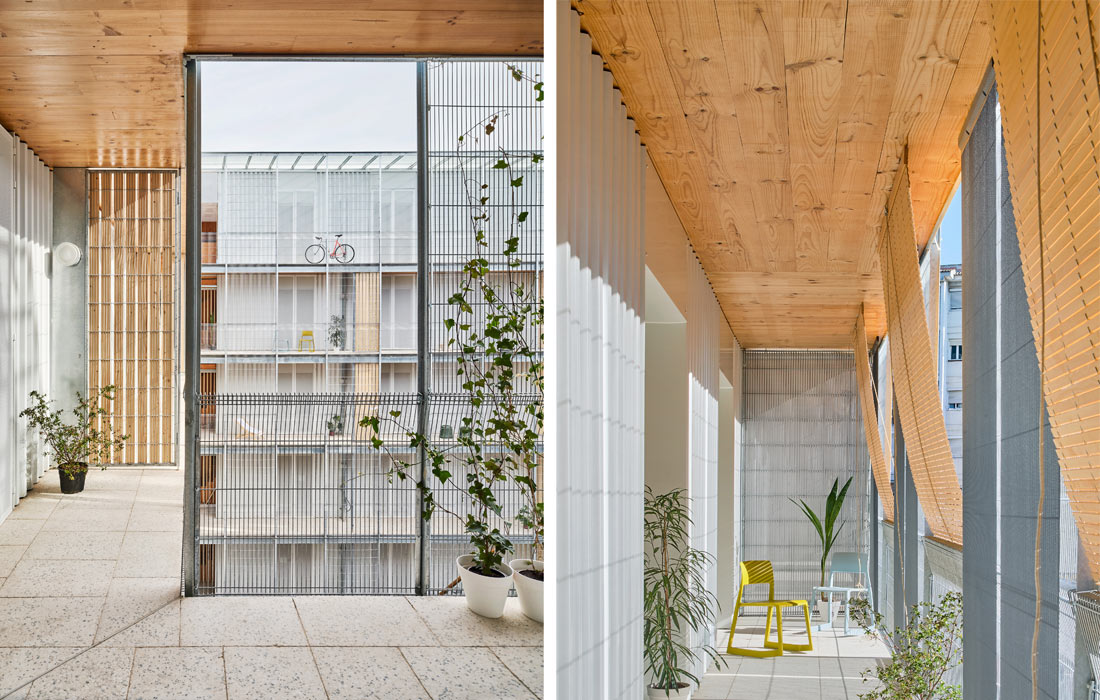A total of 8,300 m2 of zero-km wood from the forests of the Basque Country were used to build the 10,000 m2 floor area of the new building in Cornellà de Llobregat (Barcelona), consisting of 85 social dwellings across five floors. The most notable aspects of this new social housing block by the Barcelona practice Peris+Toral Arquitectes include the layout of communicating rooms to eliminate hallway spaces and make full use of the floor plan, and the use of wood to enable the industrialization of the process, improve the quality of the construction, and notably cut down on building times and reduce CO2 emissions.
In 2017, Barcelona-based Peris+Toral Arquitectes won the ideas competition organized by AMB and promoted by the public body IMPSOL to design a project for 85 social housing units on the site formerly occupied by the iconic Pisa cinema in the Barcelona municipality of Cornellà de Llobregat. They designed a freestanding residential building comprising five wood-framed floors supported by a reinforced concrete structure on the ground floor to accommodate shops and public facilities.
As the key points in their design strategy for this multifamily construction, Peris+Toral Arquitectes decided, first, to create a layout to maximize useful spaces in the floor plan and, second, to make wood the primary construction material. “We chose to work with wood due to the possibilities it offers for industrializing the structure of the building and improving both the quality of the construction and the time it takes, as well as the reduction of emissions you get with a totally sustainable material,” explains José Manuel Toral, architect and co-founder, with Marta Peris, of Peris-Toral Arquitectes and the architect responsible for the project.
The building is organized around a courtyard that connects a series of intermediate spaces. On the ground floor, a portico opens toward the city marking the doorway to the building and mediating the relationship between public space and the shared courtyard, which serves as a small plaza for the community. Instead of entering each of the building’s hallways directly and independently from the street, the four points of communication are located in the four corners of the courtyard so that all the inhabitants can coincide and meet in the courtyard-plaza. On the typical floor, access to the dwellings is via the private terraces that make up the ring of outdoor spaces overlooking the courtyard. The building’s general floor plan is organized by means of a layout of communicating rooms.
There are 114 spaces per floor of similar dimensions, a total of 543 in the building, which eliminate the need for private for communal passageways and help make full use of the surface area. The kitchens and bathrooms are arranged in the central ring while the rest of the rooms, all around the same size – approximately 13 m2 – and with the potential for multiple uses, run along the façade, and can be occupied in different ways. Another terrace in the outer ring completes the spatial sequence. The spaces are interconnected by large openings, providing air circulation, open sightlines and freedom of movement.
The 85 units are distributed into four groupings, with a total of 18 apartments per floor. Four or five homes are laid out around each core, so that each typology has cross ventilation and dual orientation. The homes consist of five or six modules, depending on whether they have two or three bedrooms. The inclusive, open-plan kitchen is located in the central room, acting as a distributor that replaces hallways, while making domestic work visible and discouraging fixed gender roles. The size of the rooms, in addition to offering flexibility based on adaptability and functional indeterminacy, allows an optimal structural space for the wooden structure. As this is social housing, the volume of wood required was optimized to 0.24 m3 per square meter of built area to ensure economic viability.

























